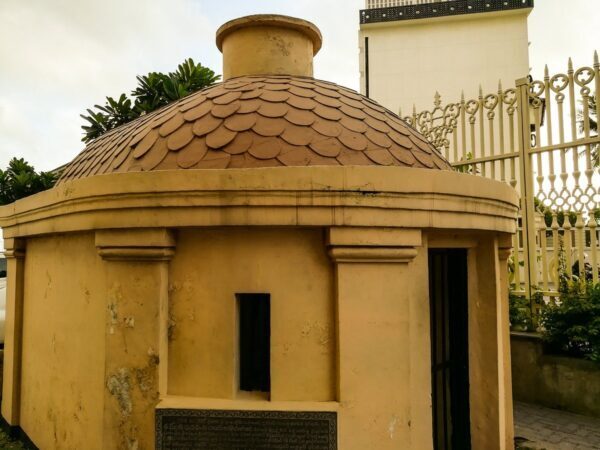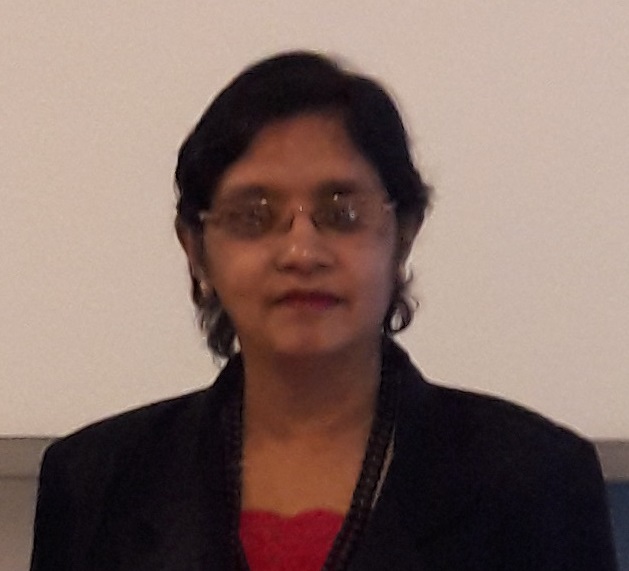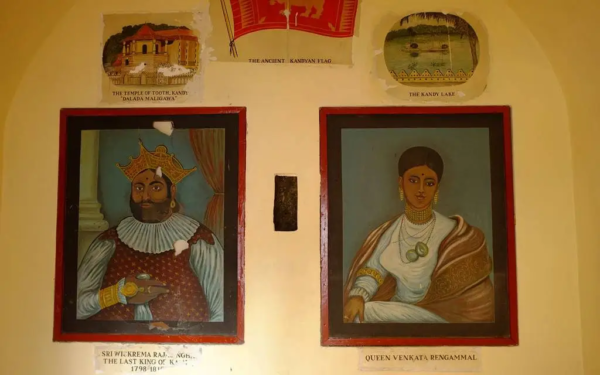Prison cell of King Sri Wickrama Rajasingha in Colombo Fort: fact or fiction?
By Arundathie Abeysinghe

 The prison cell of King Sri Wickrama Rajasingha (1798-1815), the last King of the *Kandyan Kingdom as well as the last monarch of Sri Lanka located in Colombo Fort is a well-known monument. Although, the majority of people working in Colombo Fort area are not aware of it (situated in the busy metropolis in close proximity to *Dutch Hospital in Colombo Fort), it is a popular destination of tourists.
The prison cell of King Sri Wickrama Rajasingha (1798-1815), the last King of the *Kandyan Kingdom as well as the last monarch of Sri Lanka located in Colombo Fort is a well-known monument. Although, the majority of people working in Colombo Fort area are not aware of it (situated in the busy metropolis in close proximity to *Dutch Hospital in Colombo Fort), it is a popular destination of tourists.
Situated in Janadhipathi Mawatha in Colombo Fort (Queen’s Street) at the turn off to Bank of Ceylon Mawatha within the premises of the Ceylinco House building, this small structure is engulfed in controversy, although there are paintings of King Sri Wickrama Rajasingha and his Queen Consort.
The monument is in the shape of a half capsule with the curved half facing north with a small chamber and the structure is approximately 3 meters (12 feet) in length, approximately 3 meters (11 feet) in width and approximately 2 meters (8 feet) in height. The entrance to the chamber is approximately 0.9 meters wide (3 feet) facing north with two small vertical openings on either side. There are two iron bars and the width of the walls is approximately 0.6 meters (2 feet).
The outer surface of the structure is decorated with six simple columns and has a vaulted roof with the exterior decorated in scales along with a circular ventilation duct figuring prominently on top. A noteworthy feature at the rear end of the structure is a sculptured bust of King Sri Wickrama Rajasingha with an inscription underneath. There is another inscription in Sinhala and English that describes the capture of the King as well as his imprisonment in this chamber (cell) close to the entrance, fixed on the wall. Within the chamber are portraits of the King and the Queen, portraits of *Governor Robert Brownrigg and *Adigar Pilimatalawa. The chamber also has a painting of the tomb of the King in *Vellore and the ship in which he was deported to India.
According to folklore, King Sri Wickrama Rajasingha was imprisoned in a cell in Colombo Fort before his departure and was imprisoned and placed under house arrest. There are different concepts by diverse scholars regarding this.
King Sri Wickrama Rajasingha was captured on the 18th February 1815 in Medamahanuwara in Kandy and transferred to Colombo. On 6th of March, the King and his escort entered Colombo Fort where they were received by Colonel Kerr, the commandant of the garrison. According to scholars, King Sri Wickrama Rajasingha remained in Colombo Fort for approximately a year till 24th of January, 1816 when he and his family were deported to Vellore aboard the HMS Cornwallis.
According to the Official Government Gazette and the writings of *Dr. Henry Marshall, the King was not imprisoned in a tiny cell, instead he was kept in a house, although, placed under house arrest.
According to the Gazette No. 704, Wednesday, 15th March 1815:
“On the Monday following Major Hook with the Detachment under his command escorting the late King of Kandy and his family entered the Fort…He is logged in a House in the Fort which has been suitably prepared for his reception and is stockaded round to prevent any intrusion on his privacy”
As this is an official Government document, it is considered authentic.
Dr. Henry Marshall’s celebrated work “Ceylon: a general description of the island and its inhabitants, with a historical sketch of the conquest of the colony by the English” published in 1846 has described the events in its conquest while criticizing, the British and their conduct during the 1818 rebellion. In his work, he has described the last King of Sri Lanka, his appearance, character which includes a dialogue between him and the King (when the King was residing in Colombo) in the following description:
“…. the prison or house provided for him was spacious, and handsomely fitted up. He was obviously well pleased with his new adobe, and upon entering it, observed, “As I am no longer permitted to be a King, I am thankful for the kindness and attention which have been shown to me.”
Hence, the writings of Dr. Marshall confirm King Sri Wickrama Rajasingha was placed within a house in Colombo Fort, instead of in a prison cell.
According to another work by *R. L. Brohier “Changing Face of Colombo (1505-1972): covering the Portuguese, Dutch and British Periods” the location of the King’s house in Colombo had been a Dutch dwelling later occupied by the Darley Butler Company, the present site of Ceylinco House (location of the present monument).
According to maps in National Archives and the Comprehensive Atlas of the Dutch United East India Company (Vol. IV Ceylon), this location is a residential block. Scholars have recorded that the block along Janadhipathi Mawatha in Colombo Fort from Ceylinco House to National Mutual Building (Center Point Building) had been utilized as a residential area for officers of the Dutch East India Company. As such, the present location of Ceylinco House had been the site of a Dutch House during 1700s and would have existed in 1815 too, 19 years after British Colonials took over Colombo Fort.

Hence, scholars are of the view that King Sri Wickrama Rajasingha had stayed in a house, instead of in a cell during his stay in Colombo prior to his departure to Vellore. Yet, the true identity of the present monument popular as “the cell of King Sri Wickrama Rajasingha”, its purpose and the date of construction are not clear. According to R. L. Brohier (in his Changing Face of Colombo):
“a quaint concrete cubicle in which a man can barely sit, is displayed in the court-yard off the foyer of Ceylinco House. It is popularly accredited to have been the cell in which King Sri Wickrama Rajasingha was restrained- mind you, for nearly one year. On the face of the written word and evidence of one’s own eyes, the assumption is a travesty. The monument has no greater significance possibly than that of having been a sentry box set up at the gate-way to the adjoining garrison building erected by the British in 1875 (Echelon Square buildings- now demolished)”.
Hence, R. L. Brohier assumes that this was a guardhouse of the adjoining Echelon barracks, although there are portraits of King Sri Wickrama Rajasingha and his Queen Consort.
- Adigar Pilimatalawa – During the last phase of the Kandyan Kingdom “Pilimatalawas” known as the ‘ the king makers’ of the *Kandyan Kingdom had served Royalty spanning several generations reaching their zenith under the Waduga Nayakkar Kings of Kandy. Four Pilimatalawas served as Chief Ministers, whereas Pilimatalawa Maha Adikaram III served two kings for over 20 years. Although, he was instrumental in enthroning King Sri Wickrama Rajasingha, his ultimate objective was to re-introduce a Sinhala Dynasty.
- Henry Marshall – A British Army surgeon who served in the island from 1806 to 1821. He is a celebrated Army Doctor and is considered the ‘Father of Army Medicine’. He retired as the Deputy Inspector General of Army Hospitals of the British Empire.
- Governor Robert Brownrigg (1758 -1833) – An Irish-born British statesman, soldier and1st Baronet. In 1815, he acquired the Kingdom of Kandy through an agreement with the help of defecting ministers of the Kandyan King and annexed it to the British crown. In recognition of his achievement, Brownrigg was appointed as a baronet in 1816.
- Kandyan Kingdom – A monarchy of Sri Lanka, located in the central part of the island founded in the late 15th century and endured until the early 19th century. Kandyan period covers the history of Sri Lanka from 1597–1815. After the fall of the Kingdom of Kotte, Kandyan Kingdom was the last independent monarchy of Sri Lanka and played a major role throughout the history of Sri Lanka. The Kingdom managed to remain independent from both the Portuguese and Dutch rule (who controlled coastal parts of Sri Lanka). Yet, it was colonized by the British Colonials in 1815 until Sri Lanka gained Independence in 1948.
- L. Brohier (1892-1980) – Richard Leslie Brohier (OBE, FRAS, FRGS) was a Ceylonese Burgher surveyor and writer who served as Deputy Surveyor General of Ceylon (present Sri Lanka) and Chairman of Gal Oya Development Board.
- Vellore – A city in the state of Tamil Nadu in southern India and one of the sought-after tourist places known as the ‘Fort City’. Vellore was home to diverse powerful dynasties Pallavas and Cholas.
I am grateful to my late father Mr. M.S. Abeysinghe who accompanied me to this place approximately 20 years ago and assisted me to obtain necessary details from the Department of National Archives, Sri Lanka.
Dutch Hospital – aura of Colonial Era Architecture
By Arundathie Abeysinghe
Feb 9, 2021
Articles:- Dutch Hospital – aura of Colonial Era Architecture







